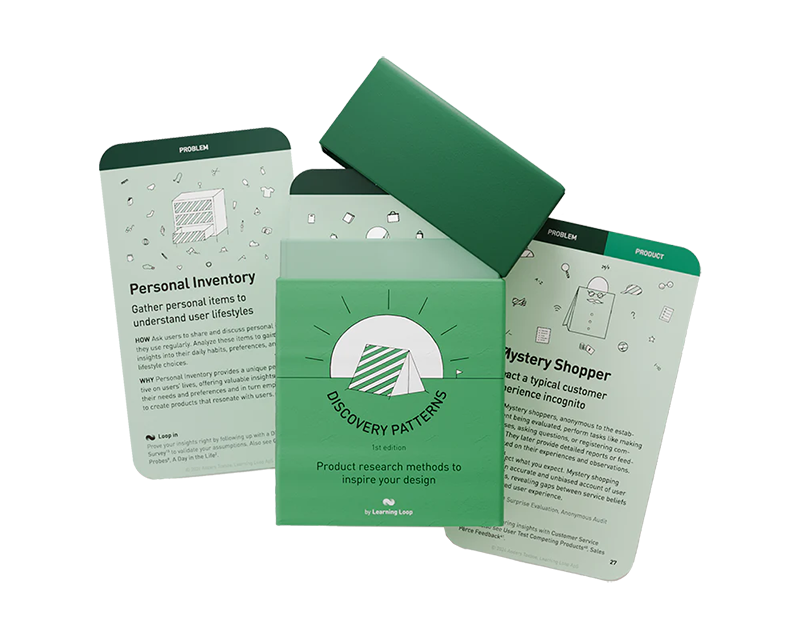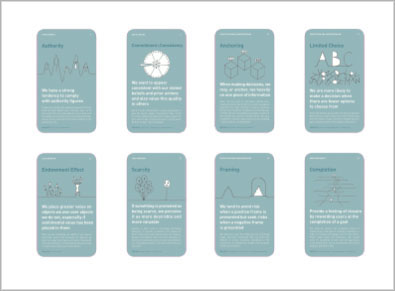How: Ask users to verbalize their thoughts, feelings, and actions while interacting with a product. Ensure a distraction-free environment to facilitate concentration and honesty. Analyze these insights to gain a deeper understanding of the user experience, highlighting areas of confusion, satisfaction, or frustration.
Why: Thinking aloud reveals real-time user perceptions and reactions, offering direct insights into user experiences, mental models, and potential usability issues.
Listening to users narrate their experience reveals the reasons behind their actions, surfacing confusion, assumptions, and mental models that analytics alone cannot capture. This insight helps product teams address usability issues early and design with a clearer understanding of user needs. Moreover, Thinking Aloud is a cost-effective and flexible approach: recruit representative users, assign them tasks, and observe silently as their verbalized thoughts guide identification of interface obstacles and opportunities for improvement.
The technique originates from the work of K. Anders Ericsson and Herbert A. Simon, whose protocol analysis framework emphasized the value of verbalized cognition during problem-solving tasks. It was later popularized in usability testing by researchers like Clayton Lewis, who adapted it for evaluating user interfaces in software design.
At its core, the method offers a window into a user’s mind, revealing not just what they do, but what they were expecting to happen, how they interpret interface elements, and where confusion arises. This can be especially useful in uncovering usability flaws early in the product development process. As Nielsen Norman Group emphasizes, the method’s simplicity, low cost, and high value make it one of the most recommended usability tools for product teams.
What is exactly Thinking Aloud?
A Thinking Aloud study typically consists of observing a participant as they attempt tasks using a prototype, live product, or design artifact. While doing so, they’re asked to continuously speak out loud about what they are doing, thinking, feeling, or expecting. Researchers watch and listen—ideally with minimal interruption—capturing valuable qualitative data about the user’s experience.
There are two dominant approaches to this protocol:
- Concurrent Think Aloud (CTA). Participants verbalize their thoughts as they complete tasks in real time.
- Retrospective Think Aloud (RTA). Participants complete tasks silently and later reflect on what they were thinking, often aided by a screen recording.
A hybrid of both is sometimes used, particularly when the product requires high cognitive load or uninterrupted attention, followed by a more reflective session.
Facilitating Thinking Aloud exercises
Facilitating a Thinking Aloud session can be deceptively tricky. Researchers must strike a balance between encouraging participants to keep talking and avoiding any influence on their behavior. As emphasized in studies like Hertzum et al. (2009), even subtle shifts in prompting—like saying “Keep talking” versus “What are you trying to achieve?”—can significantly influence the naturalness and reliability of participant behavior.
Moderators are advised to use minimal, non-directive prompts only when participants go silent, and to avoid commenting on user performance or suggesting improvements. The moderator’s role is more akin to a quiet guide, ensuring participants stay verbal without steering their behavior.
When participants talk, but not aloud
An important nuance is distinguishing thinking aloud from talking out loud. As Mike Hughes articulates, statements like “I think this background color should be blue” are opinions, not insights into cognitive processes. The goal is not to gather subjective feedback but to surface process-oriented commentary such as “I expected this button to take me back to the homepage.”
To ensure useful data, many teams start sessions with warm-up tasks—like asking the participant to count how many windows are in their home aloud—to help them practice the skill of verbalizing thoughts naturally.
Prompting participants: what to say and when to say it
Facilitators often wonder how to gently encourage participants to keep verbalizing without introducing bias. The key is to use simple, open-ended prompts that maintain the participant’s focus on their thoughts rather than their performance. Common and effective prompts include:
- “Please keep talking.”
- “What are you thinking right now?”
- “What did you expect to happen when you clicked that?”
- “Can you walk me through what you’re trying to do?”
- “What are you looking for here?”
- “How are you deciding what to do next?”
Warm-up tasks are also useful to ease participants into the session. Examples include:
- Asking them to explain how they make a cup of coffee or their morning routine.
- Asking them to describe what’s inside their fridge without looking.
- Asking them to describe how they would give someone directions to a familiar location.
As supported by Hertzum et al. (2009), prompts like “What are you trying to achieve?” tend to elicit more focused and useful commentary. However, MeasuringU warns that prompting too frequently can reduce session authenticity.
Effective vs. ineffective verbalizations
Drawing from Mike Hughes, here’s how different types of participant quotes play out:
Effective:
- “I thought clicking this would take me back.” → Reveals a mismatch in expectation.
- “I’m not sure what this icon means.” → Exposes ambiguity.
- “I feel stuck here.” → Signals a usability barrier.
Ineffective:
- “I think green is a better color here.” → Personal opinion with limited diagnostic value.
- “Users might get confused here.” → Abstract speculation not grounded in personal experience.
Variants of the Thinking Aloud exercise
While the purist method follows guidelines by Ericsson and Simon, many practitioners apply more flexible “interactive” versions. A study in the Journal of Usability Studies revealed that practitioners often engage participants during sessions to clarify or probe deeper, despite this potentially introducing behavioral artifacts. In practice, many teams accept this tradeoff, prioritizing the richness of feedback over strict methodological purity.
To clarify the differences, here’s a table comparing the major variants:
| Variant | Real-Time Verbalization | Post-Task Reflection | Requires Screen Recording | Allows Facilitator Interaction | Best For |
|---|---|---|---|---|---|
| Concurrent Think Aloud (CTA) | X | Minimal | Early usability exploration | ||
| Retrospective (RTA - from video) | X | X | Optional | Preserving natural task flow | |
| Retrospective (RTA - from memory) | X | Optional | Fast sessions, less tech-dependent | ||
| Hybrid (CTA + RTA) | X | X | X | Minimal | Deeper insights with flexibility |
| Interactive Think Aloud (ITA) | X | Optional | X | Clarifying mental models in complex tasks |
Analyzing Think Aloud data
While Thinking Aloud data can feel messy and unstructured, there are proven strategies for analysis. One approach classifies verbalizations into categories such as reading, procedure, observation, explanation, and irrelevant comments. Research highlighted in UXSpot suggests that “observing” statements—where users comment on interface behavior or their experience—often correlate most strongly with usability issues.
Additionally, researchers can extract insights from nonverbal cues like tone, pace, and hesitation. A sudden pause or a spike in vocal pitch might signal confusion even before a participant expresses it directly. These signals, often dismissed, are particularly valuable in triangulating friction points in the user experience.
Best practices for consent and data storage
When conducting Thinking Aloud sessions—especially remotely—it’s critical to address privacy and consent clearly. Participants should be informed if audio, video, or screen activity will be recorded, and should explicitly consent to the recording. As outlined in Maze’s guide, researchers should:
- Explain why the session is being recorded and how data will be used.
- Provide opt-out mechanisms if participants are uncomfortable.
- Securely store recordings and limit access to authorized team members only.
- Define retention periods for data and delete recordings responsibly once analysis is complete.
When Thinking Aloud studies is the right choice
Thinking Aloud is particularly beneficial in early design and prototype testing phases, where uncovering friction points early can prevent costly rework. It requires little more than a quiet space, a participant, and a facilitator.
Remote Thinking Aloud can introduce both advantages and trade-offs. As discussed in the UXPA Journal, some participants feel more relaxed and candid in their home environment, which can improve authenticity. However, researchers must adapt their setup and prompts to accommodate potential distractions or technical hiccups.
Here’s a comparison of Thinking Aloud with other common research methods:
| Method | Reveals Thought Process | Real-Time Behavior | Cost-Effective | Requires Tech Setup | Statistical Reliability | Ideal Use Case |
|---|---|---|---|---|---|---|
| Thinking Aloud | X | X | X | Minimal | Medium-High | Early-stage usability testing |
| Usability Testing (Silent) | X | X | Minimal | High | Task success, efficiency evaluation | |
| Survey | X | Minimal | High | Gathering broad, structured feedback | ||
| Interview | X | X | Minimal | Medium | Understanding needs, context, and preferences | |
| A/B Testing | X | X | Very High | Measuring impact of design alternatives at scale | ||
| Analytics/Session Replay | X | X | Very High | Understanding patterns and behavior at scale |
It’s cost-effective and flexible
Thinking aloud tests offers a cost-effective, robust, and flexible method that’s easy to implement. By asking users to verbalize their thoughts while interacting with a system, these tests provide direct insights into user experiences and decision-making processes. It’s a quite simple strategy: recruit representative users, assign them tasks that reflect typical use cases, and then observe silently, allowing users’ verbalized thoughts to guide your understanding of their interactions and any obstacles they encounter. This method, despite its simplicity, can unearth valuable insights into improving user interface design and enhancing overall usability.
Let users narrate
In an era of rich product analytics, AI-enhanced behavior modeling, and multivariate testing, Thinking Aloud still holds a unique position. It reminds us that many of the most valuable insights about usability aren’t buried in the data—they’re spoken aloud in the moment of interaction.
Letting users narrate their experience captures context that’s otherwise invisible. It’s not about optimizing for what users do—it’s about understanding why they do it. And that makes all the difference in designing with empathy, clarity, and real-world relevance.
Popular tools
The tools below will help you with the Thinking Aloud play.
-
Lookback
Lookback enables moderated and unmoderated user research, supporting real-time audio/video recording where users can think aloud while using your product. It offers timestamped notes, transcripts, and team collaboration.
-
UserTesting
UserTesting provides access to a broad participant panel and allows researchers to run both moderated and unmoderated usability tests. Thinking Aloud is a built-in part of their task scripts and video analysis.
-
Maze
Maze supports unmoderated usability testing with asynchronous video capture. Participants can speak their thoughts aloud during tasks, and responses can be analyzed via session recordings and Clips.
-
Dovetail
Dovetail doesn’t run live sessions but excels at analyzing and tagging Thinking Aloud recordings. It allows teams to transcribe, tag, and synthesize qualitative feedback collaboratively.
-
Condens
Condens is a qualitative data analysis tool for user research. It helps analyze Think Aloud sessions with features for video annotation, tagging quotes, and generating insights.
Real life Thinking Aloud examples
BBC
The BBC employed Thinking Aloud sessions during the redesign of their homepage. By observing users verbalize their thoughts while navigating the site, they identified usability issues and improved the interface accordingly.
Source: nngroup.com
GOV.UK
The UK Government Digital Service integrates Thinking Aloud in their moderated usability testing to understand user interactions with government services, leading to more user-friendly digital platforms.
Source: gov.uk
Mozilla Firefox
Mozilla conducted remote, unmoderated Thinking Aloud studies to evaluate features like Activity Stream and onboarding experiences, gathering insights to refine Firefox’s user interface.
Source: firefoxur.github.io
Dropbox
Dropbox utilized Thinking Aloud protocols during usability testing to gain insights into user motivations and frustrations, informing a more user-centric design approach.
Source: medium.com
A collection of clever product discovery methods that help you get to the bottom of customer needs and coining the right problem before building solutions. They are regularly used by product builders at companies like Google, Facebook, Dropbox, and Amazon.
Get your deck!Related plays
- Thinking Aloud: The #1 Usability Tool by Nielsen Norman Group
- Many Ways of Thinking Aloud by Jeff Sauro at MeasuringU
- Thinking Aloud Summary 2023 by Jeff Sauro at MeasuringU
- Talking Out Loud is Not the Same as Thinking Aloud by Mike Hughes at UXmatters
- Talking About Thinking Aloud: Perspectives from Interactive Think Aloud Practitioners by UXPA Journal Editorial Team at UXPA Journal
- Think-Aloud Testing for Usability by UXSpot
- Think Aloud Protocol by Wikipedia contributors at Wikipedia
- Think Aloud Protocol Guide by Maze at Maze
- Think-Aloud Protocols in Usability Testing by Morten Hertzum, Niels Ebbe Jacobsen at University of Copenhagen


